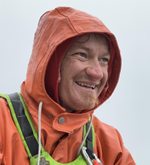
Brian Chaffin
Social-ecological river restoration: converging currents of science, governance, and resilience thinking
Thursday 9 October 2025
River restoration, including reconnection of ecosystems and revitalization of human-river relationships, cannot succeed in the modern era guided by science alone. Degradation of riverine landscapes is often deep and complex; legacies of industrial contamination layer across myriad landscape owners and human values leveraged to direct, control, and stifle natural processes. Restoration activities are further complicated by the scales at which key processes must be addressed, and the required navigation of a complex network of human values imposed on rivers, both historically and in modern legal, economic, and social contexts. ‘Resilience thinking’ offers a powerful lens for navigating this complexity. By recognizing rivers as coupled social-ecological systems, both scientists and practitioners are exposed to approaches that emphasize adaptive management, attention to feedbacks between people and ecosystems, and the capacity to work within—not outside of—human institutions and values. This perspective is especially valuable where legacies of degradation converge with deeply rooted human demands for water in riverine landscapes. To demonstrate the power of a resilience framing for river restoration, I present the challenge of river restoration in the Upper Clark Fork River of western Montana. Once the epicenter of copper mining in the USA, legacy contamination and slow but progressing remediation efforts continue to hold both public and private restoration efforts hostage, stalling progress toward system-wide recovery. The Upper Clark Fork is also a working agricultural landscape, economically dependent on the often-competing activities of irrigation and recreation. Chronic stream dewatering, combined with increasing impacts of climate change and ongoing distrust between producers and government agencies complicate restoration, even as major remediation has already occurred. At the same time, modern social and institutional processes have facilitated renewed tribal sovereignty over water which has begun reshaping water allocation and uses. In applying a resilience thinking lens to this case, I illustrate how river restoration science and practice can move beyond a reliance on technical fixes to embrace and leverage complex social-ecological realities, building pathways toward more durable and impactful restoration outcomes.